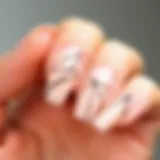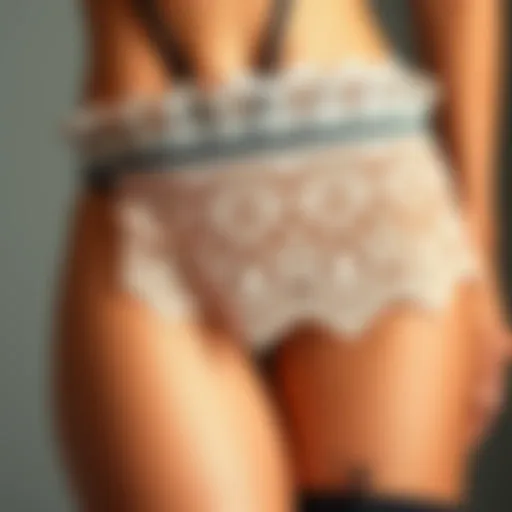Exploring the Aesthetic of 1970 Disco Outfits
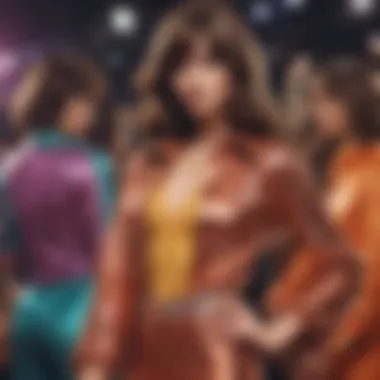

Intro
The 1970s ushered in a revolutionary shift in style, with disco taking center stage not only as a genre of music but as an extravagant cultural movement. This era of glitz and glamour did more than just influence the club scene; it laid the groundwork for future fashion trends. As we step back into this iconic time, we explore how colorful fabrics, bold aesthetics, and an unapologetic desire for self-expression became the hallmarks of a generation dominated by disco.
Fashion during the 1970s became a canvas, allowing individuals to express their identities amidst societal changes. From sequined shirts glimmering under strobe lights to flared pants that created a sense of movement on the dance floor, disco fashion was not just about garments; it represented the jubilance and freedom of its time. Through this exploration, we will dissect the mechanics of the aesthetic that fueled the disco era and its lasting impact on modern design.
Fashion Trends and Insights
Disco fashion, marked by its vivid colors and extravagant styles, shaped the aesthetics of the 1970s. Understanding the trends from that time provides valuable insights into today's fashion landscape.
Current Trends in Clothing Styles
The pulse of current fashion often taps into retro influences. Present-day designers are heavily inspired by the disco era's ethos—think metallic finishes, shimmering fabrics, and bold prints. Styles like wide-leg trousers and fitted tops have made a comeback, often consumed through a modern lens.
- Metallic Hues – Silver and gold fabrics that catch the light, much like the original disco outfits
- Bold Patterns – Funky graphics and psychedelic prints that draw inspiration from the artistic expressions of the 70s
- Tailored Silhouettes – High-waisted bell-bottoms and fitted garments reflecting the freedom and fluidity of movement.
Many retailers are tapping into this nostalgia to create pieces that resonate with both those who lived through the disco era and newer generations seeking to channel its vibrancy.
Influential Fashion Icons and Movements
Two key figures deserving attention are Halston and Donna Summer. Halston, with his minimalist yet striking designs, epitomized the glamour associated with the disco era. His influence extended beyond fashion, as he captured a cultural moment that went hand in hand with nightlife.
On the other hand, Donna Summer, often dubbed the 'Queen of Disco', not only set trends with her performance outfits but also became a symbol of empowerment for many. The outfits she wore on stage have inspired countless from both the music and fashion industries.
"Fashion is not about the brand, but the way it makes you feel," said Halston, perfectly encapsulating the spirit of disco.
As these influences are revisited within today’s trends, they remind us of the continuous cycle of inspiration and reinvention in fashion. It highlights not just a nostalgia but an appreciation for the artistry that emerged during an era marked by grooves and carefree vibes.
Sustainable Fashion Practices
In today’s world, looking back at the flamboyant past of disco fashion invites a broader conversation about sustainability in fashion design. As the industry grapples with its impact on the environment, it's crucial to explore ways of marrying vintage allure with eco-conscious practices.
Eco-Friendly Fabrics and Materials
Many modern designers are recognizing the importance of sustainable options, seeking materials that are not only stylish but also environmentally friendly. Organic cotton, hemp, and recycled polyester are becoming popular choices, echoing the original ethos of creativity and self-expression from the disco era. A nod to the past can encourage more responsible choices in contemporary wardrobes.
Tips for Building a Sustainable Wardrobe
To channel the vibrant styles of the 70s while maintaining a commitment to sustainability, individuals can do the following:
- Thrift Shopping – Vintage shops often hold hidden treasures from the 70s that embody the disco spirit.
- Mix and Match – Get creative with existing pieces, pairing them with sustainable finds.
- Choose Quality Over Quantity – Investing in well-crafted pieces that stand the test of time contributes to not only a stylish wardrobe but a sustainable one.
The journey of analyzing disco fashion is about appreciating its energy and artistry while also considering how these aesthetics can thrive sustainably in the 21st century. As we draw connections between the past and the present, the legacy of disco outfits continues to inform and inspire.
Prelude to the Disco Era
The 1970s heralded a cultural revolution that extended far beyond music, merging dance, art, and fashion into an artistic tapestry. During this decade, disco emerged not merely as a genre of music, but as a lifestyle and a societal phenomenon. Understanding this period is crucial not only to appreciate its vibrant outfits but also to grasp the collective influence it had on social dynamics and self-expression. This exploration into the disco era reveals how clothing became a vehicle for individual identity and community belonging.
Cultural Context of the Seventies
The cultural climate of the seventies was one marked by significant shifts. Post-Vietnam War disillusionment, the civil rights movement, and feminist waves were brewing simultaneously. In a time characterized by transitions, people sought new outlets for expression, leading to the emergence of nightclubs as bastions of liberation. These venues transcended their physical boundaries, operating as cultural incubators where individuals of diverse backgrounds mingled, danced, and forged a unique communal identity.
Disco culture became synonymous with glamour and seduction, often set within the shimmering walls of nightclubs where patrons adorned themselves in eye-catching outfits designed to both reflect and enhance their self-image.
The Rise of Disco Music
Disco music, a fusion of soul, funk, and psychedelic rock, not only incited people to hit the dance floor but also solidified its grip on popular culture. Icons like Donna Summer and the Bee Gees brought disco to mainstream attention, with their infectious beats and catchy lyrics. The rhythm of disco embodied freedom and exuberance, invigorating the youth with a sense of awakening.
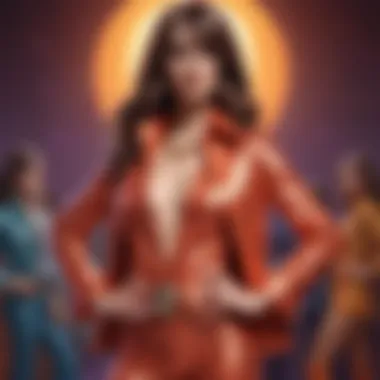

As disco tracks spun on turntables, they also acted as a soundtrack to evolving fashion. The connection between the pulsating music and striking outfits soon became undeniable. The louder the beat, the bolder the attire, with outfits echoing the flamboyant sounds that filled the airwaves.
Influence of Nightclubs on Fashion
The nightlife scene unequivocally influenced fashion trends of the disco era. Nightclubs like Studio 54 and The Paradise Garage set the stage for unabashed expression where dress codes leaned towards the extravagant. Glitter, satin, and sequins became almost a uniform, signaling a warm welcome to all those who understood the hidden meaning of fashion as identity.
In these vibrant spaces, the exchange of style was rampant; fashion could be as vast as a bold metallic jumpsuit or as refined as a patterned blouse paired with tailored trousers.
"Clothing was not merely for warmth but a way to display one's individuality—an audacious proclamation that—'I am here, and I am fabulous.'"
The nightclub experience was immersive, and the clothes worn encapsulated a very sensory delight, turning the wearer into part of the art. This influence is still felt today, as modern clubs echo the same principles of creativity, expression, and excitement through their revelers’ fashion choices.
Through examining this rich context, it becomes clear how the aesthetic of disco outfits was not only a visual statement but a profound manifestation of a collective yearning for joy, freedom, and acceptance.
Key Characteristics of Disco Outfits
Disco fashion is like a painting on the canvas of culture, vibrant and alive with personality. The importance of understanding the key characteristics of disco outfits lies in their reflection of an era that thrived on freedom, expression, and creativity. Elements such as color, material, shapes, and fits don't merely represent clothing choices; they illustrate a dominant cultural wave. By dissecting these aspects, one gains a comprehensive appreciation of the disco aesthetic, which continues to influence modern styles.
Vibrant Colors and Patterns
Disco's vibrant color palette and bold patterns are among the most striking features of the era's fashion. This period thrived on exuberance, and the garments showcased it beautifully.
Neon Hues
Neon hues were a hallmark of the disco aesthetic, adding a pulse of energy that mirrored the electric vibe of the dance floor. These vivid, almost fluorescent colors weren't just eye-catching; they encouraged individuals to express their spirits brightly and boldly. Wearing neon was an invitation to be seen, to stand out. The unique feature of neon is its ability to amplify visibility in dimly lit club environments, enhancing the atmosphere. However, the downside can be its overwhelming nature for those who prefer subtler shades.
Floral Prints
Floral prints emerged as another significant aspect of disco attire, often adding a touch of whimsical charm. These patterns conveyed a sense of liveliness and romance. They were a favorite for both men and women, creating versatile options across various garment types. The key characteristic of floral prints is their adaptability; they can range from bold, oversized designs to delicate, understated motifs. While they tend to evoke a feminine vibe, floral prints can easily lean toward unisex appeal, providing diverse styling opportunities. A potential disadvantage, however, is that certain floral designs might date quickly, making them less favorable for long-term wear.
Geometric Designs
Geometric designs brought a more structured visual element to disco fashion. These shapes were often bold and repetitive, creating a visual rhythm that could be as captivating as the music on the dance floor. The significance of these designs is that they evoke a sense of modernity and innovation, fitting seamlessly into the aesthetic of the era that relished in newness. Geometric patterns, with their rigid lines and sharp angles, offer a striking contrast to the fluidity of floral prints. The challenge with geometric attire, though, lies in finding the right balance; overdoing it can lead to a clash rather than a cohesive look.
Material Choices
Materials played a crucial role in defining the tactile experience of disco outfits. The fabrics selected were not just about aesthetics but also about how they interacted with movement and light.
Polyester and Synthetic Fabrics
Polyester and synthetic fabrics were favored for their durability and ability to hold vibrant colors. These materials often came with a sheen that caught the club lights, enhancing the overall spectacle of a disco outfit. The versatility of polyester allowed for a range of styles, from body-hugging designs to flowing garments. While they offered easy maintenance and significant affordability, some may argue that the fabric's breathability is lacking, which can be a consideration for extended wear.
Sequins and Shimmer
Sequins were the real show-stoppers, transforming any outfit into a dazzling spectacle. Their reflective qualities captured light in a way that was almost magical, making people shine on the dance floor. The key appeal of sequins lies in their celebratory nature; wearing them feels like a statement of joy and festivity. However, a potential downside is the discomfort that can come with them—sequins can snag and irritate without careful choice in garment construction.
Suede and Leather
Suede and leather, often associated with a cooler, edgier vibe, were also integral to disco aesthetics. These materials provided a tactile richness and a feeling of luxury. They could elevate an outfit's status, emphasizing a bold, confident style. The unique feature here is their durability and timeless appeal; they can easily transition into modern wardrobes. Still, consider that these materials often require more upkeep, including specific cleaning methods to maintain their quality.
Silhouettes and Fits
Fit and silhouette are critical in commanding presence on the dance floor. The shapes of disco outfits are telling of the era's fluid approach to gender and expression.
Bell-Bottom Pants
Bell-bottom pants serve as an iconic representation of the disco silhouette. Broader at the hem, they flowed with movement, creating a dramatic effect as people danced. This style enhances leg length and offers a playful touch to any outfit. The distinct characteristics of bell-bottoms make them a popular choice for both genders, adapting easily to various tops. However, their dramatic flair may not suit every body type, requiring careful styling considerations to work effectively.
Cropped Tops
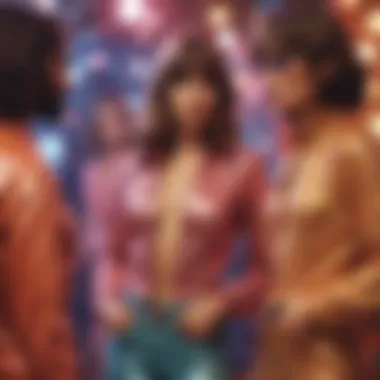

Cropped tops are another important part of the disco fashion scene. These garments reveal a portion of the midriff, which was seen as adventurous and liberating. The cropped look provides an element of playfulness and flirtation, pairing easily with high-waisted bottoms. Their key characteristic is versatility; they can transition from casual to glam with simple accessorizing. One downside is that they may not be the best fit for layering, limiting their use in colder weather.
Maxi Dresses
Maxi dresses embraced the freedom of movement while remaining effortlessly chic. Flowing to the ankles, they often showcased unique hues and patterns typical of disco attire. Their relaxed fit promoted comfort without sacrificing style, appealing to those who enjoyed dancing without constraints. The charm of maxi dresses is in their range of styles—from bohemian to glam—allowing for personalization. Conversely, shorter individuals may find that the length can overwhelm their frame, requiring careful selection of style and accessories to maintain a balanced appearance.
Iconic Disco Looks Known to Influence
Disco fashion in the 1970s wasn't just clothing; it was an entire movement that blended music, art, and culture. The flashy outfits and extravagant styles of the time left an indelible mark on how we perceive aesthetics today. By exploring the influential looks that emerged during this vibrant era, we get a peek into the societal shifts and pop culture phenomena that shaped them. From the glitz of Studio 54 to the iconic films that brought disco into homes, the iconic looks showcased a flamboyance that signified freedom and self-expression, important aspects to comprehend in our current diverse fashion landscape.
The Influencer Effect of Disco Icons
When we think of disco icons, names like Donna Summer and the Bee Gees resonate immediately. Their influence went beyond just music, as their styles set trends that became synonymous with the era. These personalities were not merely entertainers; they were symbols of a lifestyle that embraced individuality and euphoria, which is why their fashion choices remain relevant today in discussions of glamour and self-expression in fashion.
Studio and Its Legends
Studio 54 stands tall as one of the ultimate emblems of disco culture. This infamous nightclub attracted celebrities, artists, and fashion-forward individuals, all eager to showcase their bold styles. The key characteristic of Studio 54's influence lies in its ability to blend high fashion with nightlife aesthetics. Outfits donned within those walls often featured sequins, striking color contrasts, and avant-garde designs that not only highlighted personal style but also echoed the jamboree of sounds filling the air.
The unique feature of Studio 54 was its role as a creative hub. It was a place where fashion was not only shown but also born. This environment fostered trends that could be bold and loud or sultry and understated - depending on the whims of its attendees. However, one must consider the downside of this exuberance; the pressure to conform to the perception of glamour could at times feel overwhelming for individuals, especially those who might not have had the means to afford such lavish looks.
Disco in Film and Television
Disco permeated not only clubs but also television and cinema, painting a picture of a colorful lifestyle. Movies like Saturday Night Fever and shows like Soul Train showcased dancing and fashion in a way that made them inseparable. The key aspect of this influence was the visual representation of disco style, which reached millions and solidified what disco fashion meant.
Through film and television, iconic outfits—such as the polyester suits and glittery dresses—became emblematic of the disco era. This exposure allowed designers and brands to see the commercial potential in these styles, making them available to the masses. Nonetheless, it did create a certain degree of commercialization that might have compromised the originality of the styles, leading to diluted versions nonetheless, the images and aesthetics presented through film remain a vital part of fashion’s evolution.
The Connection Between Music and Fashion
Music and fashion have always shared a reciprocal relationship, especially during the disco era. When the beats dropped, so did the barriers between what was considered clothing appropriate for dance and everyday life.
Fashion in Music Videos
As we delve into the aspect of music videos, it’s evident that they played a significant role in popularizing disco fashion. Artists like Diana Ross and Freddie Mercury embraced extravagant looks that turned heads and captured hearts. Each music video became a canvas, showcasing outfits that we'd come to associate with fun, freedom, and the allure of the night.
The unique feature of fashion in music videos is how they showcased entire lifestyles, turning music performers into trendsetters. Videos served as visual invitations to audiences, encouraging them to adopt styles that harmonized with the music. This synergy between pleasing aesthetics and rhythm highlighted fashion’s inherent power to evoke emotions. However, there is a risk in solely relying on television and music influences, as it can create unrealistic standards of beauty and style.
The Role of Performers in Shaping Styles
Musical performers not only rocked the stage but also dictated what was deemed fashionable. Stars like Cher and Kylie Minogue didn't just wear outfits; they made fashion statements that echoed through culture. They transformed the perception of clothing from mere fabric into art—an experience meant to be felt and enjoyed.
The key characteristic of performers shaping styles is their unparalleled ability to inspire. Audiences looked up to these figures, often mirroring their looks and lifestyles. However, while their influence can spark creativity, it can also lead to a homogenization of style, where originality is cast aside in favor of emulation. This gives rise to a discussion about the balance of inspiration against creativity in fashion.
In summary, understanding the various aspects of iconic disco looks provides valuable insights into how cultural shifts and social dynamics influence fashion. By recognizing the interplay between music, film, and individual expression, we can appreciate the artistry and individuality that disco outfits brought into the world. Whether it was the electrifying aura of Studio 54 or the timeless influence of disco in media, these elements remain significant for designers, retailers, and fashion enthusiasts alike.
Fashion Subcultures of the Disco Era
The disco era was not just a musical revolution but a cultural phenomenon that transformed numerous aspects of society, particularly fashion. During the 1970s, various fashion subcultures emerged, significantly influencing not only the disco scene but also the broader fashion landscape. These influences were distinct and myriad, stemming from the diversity of communities and social movements that thrived during that time.
One of the most notable aspects of these subcultures was the blending of different styles—from African-American roots in funk and soul to the flamboyance of glam rock. This blending created a smorgasbord of fashion expressions that encouraged individualism and creativity. Designers, retailers, stylists, and influencers of that era learned to navigate these influences while catering to an audience that was eager for expression.
The eclectic nature of disco fashion meant that each subculture brought its own signature elements to the dance floor. Let's delve into a couple of these influential trends that left a lasting mark.
The Glam Rock Influence
The glam rock movement originated in the early 1970s, defined by its bold aesthetics and theatrical performances. Artists like David Bowie and Elton John brought a flair for the dramatic, sporting vibrant colors, metallic fabrics, and extensive glitter—elements that seamlessly found their way into the disco scene. Glam rock outifts typically featured:
- Platform shoes: These elevated footwear options were iconic and added a striking height for performers and dancers alike, making them essential for any disco ensemble.
- Brocade Jackets: Often adorned with sequins and flashy patterns, these jackets radiated a sense of extravagance, allowing the wearer to stand out in the rhythmic chaos of the dance floor.
- Faux Fur Coats: Luxurious and eye-catching, these coats were often paired with skin-tight pants or mini dresses, embodying a lavish lifestyle that many aspired to emulate.
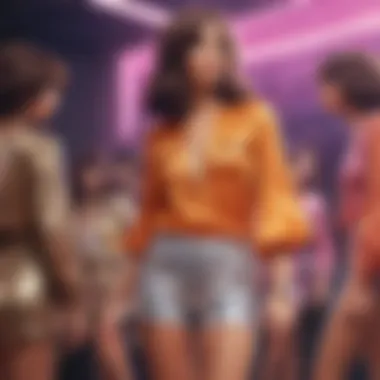

The styles promoted by glam rock were not just about aesthetics; they also represented a rejection of traditional gender norms. The androgynous look encouraged self-expression, allowing individuals to experiment and redefine their identities freely. In a truth-in-fashion moment, disco-goers began embracing these bolder looks, seeing them as a form of personal empowerment.
Dance Clubs and Their Unique Styles
When it comes to the disco era, the influence of dance clubs cannot be overstated. Discotheques like Studio 54 became the epitome of luxury, where patrons showcased their interpretive styles in front of a glamorous backdrop. These clubs served as a melting pot of fashion, style, and music, shaping their visitors' wardrobes in the process.
Each club had its own character, often influencing the outfits of its patrons. For example:
- Studio 54: Known for its exclusivity and star-studded crowd, outfits worn here were often over-the-top; think metallic jumpsuits or gowns dripping in rhinestones that left everyone in awe.
- The Sanctuary: With its underground vibe, it attracted a more bohemian crowd drawn to vintage flare pants and flowing blouses, further blending the aesthetics of hip fashion with disco.
Even the mood lighting of these venues shaped style choices, as the flashing disco balls and color-changing lights served to accentuate vivid patterns and shiny materials of the garments. It became as much about the experience as it was about the clothing—an all-encompassing celebration of life itself.
"In the disco’s throbbing heart, every outfit told a story; the dancers were not merely dressing to impress, they adorned themselves to express—who they were, and who they wished to be."
Thus, these fashion subcultures during the disco era were more than transient trends; they were pivotal movements that not only shaped the identity of disco but also acted as a precursor to modern styles, often drawing inspiration from these distinctive elements.
The Lasting Impact of Disco Fashion
Disco fashion has left an imprint that stretches well beyond the dance floors of the 1970s. This exceptional period opened the doors to a new perspective on personal expression, closely tied to the accompanying music and culture. The importance of disco fashion lies in its exploration of identity, freedom, and creativity. In many ways, the daring outfits served as a canvas for individuals to express their authentic selves in a vibrant social landscape. Today, it's critical to recognize how those styles inform contemporary wardrobes and continue to inspire designers.
Revival Movements in the Fashion Industry
In recent years, the fashion industry has seen a notable resurgence in disco-inspired styles. This revival isn't merely a nostalgic nod to the past but a full-fledged embrace of the aesthetic that defined a generation. High fashion runways and street fashion alike have started incorporating elements reminiscent of the disco era. Styles such as bold sequins, dramatic flares, and vibrant prints are once again making waves.
The revival movement draws excitement not only from nostalgia but also from innovative approaches in merging retro with modern details. Designers like Gucci and Maison Margiela have found ways to reinterpret these elements, creating collections that evoke the glitz of the disco era with a modern twist. This interplay between old and new is essential, illustrating the timelessness of the disco aesthetic and its adaptability to contemporary tastes.
Modern Adaptations of Disco Styles
Current Fashion Trends Inspired by Disco
Disco fashion never truly went away; it merely evolved. One of the most prominent trends today is the blurring of gender lines in clothing. Designers are exploring unisex garments that take cues from the boldness of disco. This fluidity in fashion reflects a broader cultural shift towards inclusivity and freedom of expression.
Key characteristics of Current Fashion Trends Inspired by Disco include:
- Color Explosion: Designers are unabashedly drawing from vibrant color palettes that echo the original disco vibes. Neon colors and daring patterns are prevalent choices.
- Luxurious Fabrics: Materials like satin and velvet have come forward, reminiscent of disco's original glam.
- Statement Pieces: Items that stand out, such as flamboyant jackets and flashy shoes, are returning to the fashion lexicon.
These elements resonate well with shoppers seeking to make bold fashion statements, making them beneficial choices in this article.
"Disco wasn't just about the music; it was an entire lifestyle, woven into the very fabric of society."
Styling Tips for Contemporary Wear
Incorporating disco elements into modern-day outfits can be an exciting venture. A few styling tips for contemporary wear include:
- Layering: Don’t hesitate to mix various textures and patterns. For example, pairing a sequined top with a classic black skirt can strike the right balance between fun and classy.
- Accessorizing: Accessories like chunky jewelry or oversized sunglasses can instantly elevate an outfit, adding that disco flair without overwhelming a look.
- Footwear Choices: Platform shoes are making a comeback. They not only add style but also bring a nostalgic touch to any ensemble.
Each of these elements provides unique ways to express personal style while embracing the disco-inspired revival. As enthusiasts look to incorporate these trends, they find that these options are versatile—suitable for both casual outings and upscale events.
In sum, disco fashion is stylishly in vogue once more. It exemplifies the enduring allure of self-expression and creativity. The ongoing dialogues within the fashion world about these revisited styles reveal that the disco era will continue to inspire for years to come.
Finale
As we wrap up our exploration of the aesthetic of 1970 disco outfits, it becomes clear that this era's fashion was not merely about fabric and design; it was a vivid expression of cultural revolution and individualism. Disco attire embodied a spirit of freedom, self-expression, and unabashed confidence, feelings that resonate even today. The vibrant colors, bold patterns, and distinct silhouettes do more than tell a story; they captivate the imagination.
The Enduring Allure of Disco Fashion
Disco fashion retains a magnetic appeal, influencing modern styles in ways both subtle and overt. Here are a few reasons and elements that highlight its enduring allure:
- Cultural Fusion: The disco era was a melting pot of influences—ranging from glamorous Hollywood aesthetics to the underground vibes of urban nightclubs. This amalgamation of styles fosters creativity in today’s fashion landscape.
- Individuality: The disco outfits encouraged wearers to showcase their unique personalities. Whether through sequined jumpsuits or shiny bell-bottoms, each ensemble was a canvas for self-expression.
- Evolution of Dancewear: The functionality combined with style in disco fashion paved the way for modern athletic and street styles. Designers today often revisit these festive styles, making them more accessible while retaining their original flair.
"Fashion is about expressing you, something that disco outfits nailed perfectly, allowing a party for the eyes while celebrating the spirit of the time."
- Social Impact: Disco fashion made a mark not only as a trend but also as a catalyst for social movements—celebrating diversity, sexual freedom, and the liberation of marginalized groups. The impact of these clothing choices transcends the fabric, as they contributed to larger cultural shifts.
In summary, the aesthetic drawn from disco not only laid the groundwork for current fashion but also continues to inspire designers, stylists, and influencers. With fresh interpretations of classic looks, the echoes of disco remain alive, reminding us that fashion, at its best, is a reflection of our culture and identity.
